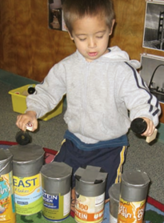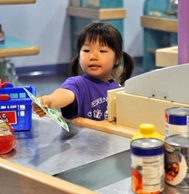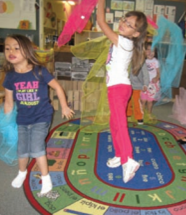11.1: Introduction
The creative arts are as natural to young children’s lives as language and play are. The arts build skills such as problem-solving and critical thinking; they bring parallel opportunities for the development of language/communication, mathematics, and the development of social and interpersonal skills. The following activities are often referred to as children’s play: scribbling with a crayon, pretending to be a pirate or a bird, humming bits of a tune, banging on a drum, or swaying to music. But these behaviors in fact show elements of artistic expression and creation that support the continuous development of artistic skills. They also show the hallmarks of children’s abilities to express themselves through symbols and aesthetic images.[1]
The creative arts domain is presented in four familiar disciplines:
Table 11.1: Creative Arts Disciplines
| Examples of Art | Types of Art |
|---|---|
 |
Visual Art: The visual arts include the practice of drawing, painting, sculpting, and assembling collages in two or three dimensions. Preschool visual art is process-based and open-ended, allowing children to explore by using a variety of materials. The product is not the focus, though the children will likely view their creation as a masterpiece! |
 |
Music: Preschoolers love to listen to music as well as sing along and move with music. Music learning in preschool is a time to make new discoveries. Preschoolers can engage in music making, performing rhythms, musical sounds and passages with a variety of instruments, or simply sing along to a favorite tune. |
 |
Drama: For preschoolers, this domain involves both spontaneous dramatic play and teacher-structured drama, each of which inspires the other. Preschoolers are naturally inclined to engage in solitary, parallel, and group play, and draw on these experiences when acting out situations and using props (with teacher guidance). Similarly, engaging in drama feeds children’s imagination and inspires dramatic play. A goal in dramatic play and drama for preschoolers is unleashing the child’s imagination. Thus, the focus is on children’s creative engagement in drama rather than on actual performance or “the theater.” |
 |
Dance: The dance domain for preschoolers is interested in the creative and often expressive use of movement. Movement is explored in all its range (e.g., small and large, fast or slow, hopping or marching) and for various purposes, such as learning math or language skills, or for the joy of moving. Dance can be a nonverbal tool for expressing ideas, telling stories, or communicating emotions. It is often rhythmic and accompanied by music. Requiring thinking, social interaction, and physical exercise, dance is a motivating way for preschoolers to engage in learning. |
The specific foundations, which are the knowledge, skills, and behaviors that preschool children typically develop in a quality preschool environment as they relate to visual art, music, drama, and dance are included later in the chapter as each strand is explored.[1]
- The California Preschool Curriculum Framework, Volume 2 by the California Department of Education is used with permission ↵

